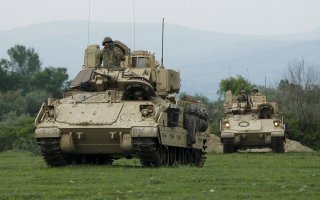The U.S. Army's M2 Bradley Isn't Dying Without a Fight
Past replacement efforts haven’t exactly been met with positive results.
Here's What You Need to Know: The Bradley Fighting Vehicle remains a critical component in the U.S. Army.
While the U.S. Army is continuing to seek a replacement for the Cold War Bradley Fighting Vehicle (BFV), the past efforts with the optionally manned fighting vehicle (OMFV) program haven’t exactly been met with positive results. In the meantime, the M2 Bradley—the fighting platform no one really wanted or really needed—continues to live on.
The latest variant, the M2A4 has been undergoing testing at the facilities of the 3rd Cavalry Regiment of the 1st Cavalry Division of the U.S. Army at Fort Hood, Texas. The U.S. Army Operation Test Command has been conducting exercises with the upgraded Bradley, which features a new 8-cylinder Cummins VTA903E-T675 diesel engine with a capacity of 675 horsepower; and a new HMPT-800-3ECB hydraulic transmission. These improvements will allow the fighting vehicle to utilize the Iron Fist Light Decoupled (IFLD) active protection system for armored vehicles developed by the Israeli Elbit Systems company, Defence-Blog reported.
This latest upgrade also provided the Bradley with new lightweight tracks, new shock absorbers, and suspension, as well as stiffer torsion bars. According to reports, this increased the ground clearance from 380 to 510 millimeters, which improved the mobility but also enhanced the protection of the vehicle from anti-tank mines.
The Bradley M2A4 is armed with a Bushmaster 25mm cannon that can fire both explosive and armor-piercing rounds. It is also equipped with TOW missiles to defeat enemy armor and a 7.62mm coaxial machinegun.
BFV Virtual Trainers
The U.S. Army also placed a new order with DiSTI Corporation, a provider of 3D virtual training solutions and graphical user interface (GUI) software, for its Diagnostic Troubleshooting Trainers (DTT) and classroom hardware as part of the Family of Maintenance Trainers (FMT) program.
“The Bradley Fighting Vehicle is a critical component in the U.S. Army’s Armored Brigade Combat Team and the combat vehicle modernization strategy,” said DiSTI CEO John Hayward. “The DiSTI Corporation is committed to continuing our mission of developing world-class, immersive training to ensure efficacy and force readiness.”
This solution is meant to extend the existing BFV DTT prototype lessons by including 80 maintenance and troubleshooting lessons and procedures. These variants of the Bradley Fighting Vehicle are equipped with enhanced features that provide rapid movement in reaction to combat or other adverse situations, protecting soldiers between critical points.
DiSTI’s virtual training solutions were designed to allow students to train in an advanced 3D learning environment to garner the skills necessary for BFV maintenance. This program will provide the U.S. Army with immersive, cost-effective training that improves student throughput, engagement, and learning outcomes.
Installation of classrooms featuring the Bradley Fighting Vehicle DTT trainers will occur in Fort Benning, Georgia, Fort Lee, Virginia, and Camp Shelby located near Hattiesburg, Mississippi.
The virtual training tools are just the latest high-tech enhancements on the platform that dates back to the days of Pong. Earlier this year U.S. Army soldiers began operating with BFVs that were modified to acquire enemy targets with the assistance of drones. The modified Bradleys, called Mission Enabling Technologies-Demonstrators (MET-Ds), controlled several Robotic Combat Vehicles up to a 2,000-meter range.
Peter Suciu is a Michigan-based writer who has contributed to more than four dozen magazines, newspapers and websites. He is the author of several books on military headgear including A Gallery of Military Headdress, which is available on Amazon.com.
This article first appeared in November 2020.
Image: U.S. servicemen drive Bradley infantry fighting vehicles during the joint U.S.-Georgian exercise Noble Partner 2015 at the Vaziani training area outside Tbilisi, Georgia, May 17, 2015. REUTERS/David Mdzinarishvili

